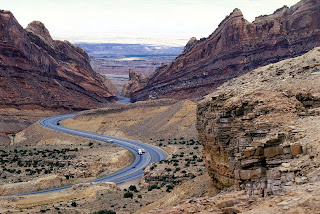 |
| The Old Spanish Trail route |
The trail that we refer to as the Old Spanish Trail was, for the most part, originally used by ancient Native Americans. It were largely these ancient trails that connected to form the trail used by the Spaniards as early as 1670.
The Old Spanish Trail, some 1,120 miles in length, while used by the Spaniards for commerce and migration as well as for transporting Native American slaves, dates to the late 1600's. It was not until about 1830, after the Spaniards had left North America and the Mexican government was formed that the trail was used as a regular commercial route.
The Mormans used the western part of the trail beginning in the 1840's as a wagon route for settlers heading west. The Mormon presence on the Old Spanish Trail disrupted the transportation of slaves over the route. That part of the trail is also referred to as the "Mormon Corridor".
 |
| Los Angeles plaza, 1869 |
The Old Spanish Trail was anything but a straight line. Leaving Santa Fe New Mexico, the route traveled west/northwest toward Utah. What was being circumnavigated were the Grand Canyon and the Glen Canyon, two obstacles that were too formidable to cross. The north branch of the trail crossed the San Luis Valley in present day southern Colorado.
Heading westward the trail crosses central and southern Utah where it took another turn to the south. The present day town of Ucolo Utah is where the Old Spanish Trail entered that state. The trail crosses the Colorado River near the present day town of Moab Utah. The next river crossed in Utah was the Green River.
The trail continues to the north of San Rafael Swell and reached it's northernmost point in present day Emery County Utah. After that the Old Spanish Trail runs across the Great Basin and through the Mojave Desert on it's way toward Los Angeles.
 |
| Palace of the Governors, Santa Fe plaza |
Woolen goods, mostly blankets and rugs were transported west by the New Mexicans which during that period was referred to as Nuevo Mexico. The largest traffic on the reverse route eastward were horses and mules.
Old Spanish Trail Historic Sites to See Today
Today, the Old Spanish National Historic Trail covers the states of New Mexico, Colorado, Utah, Arizona and California. Santa Fe New Mexico itself served as a hub since it tied in directly with the Santa Fe Trail connecting to eastern markets.
There are museums and historic sites all along the way that can be fun additions to your next western trip. The trail is so lengthy that starting from any location such as Santa Fe, New Mexico; Alamosa and Durango, Colorado; Las Vegas, Nevada; St. George, Utah; Flagstaff, Arizona; and Los Angeles will work well.
More Western Trips photo articles of interest are on the links below...
The Pueblo Revolt and the Spaniards
The Ancient Cliff Dwellings in Colorado
 |
| Alamosa Colorado |
Another good museum to add to your western trip planner is the Museum of Moab in Moab Utah which displays many historic artifacts from the Old Spanish Trail days and before.
The San Luis Valley Museum in Alamosa Colorado has a large amount of information and exhibits about San Luis Valley history and it's Hispanic and Native American heritage.
Thirty miles west of Green River Utah is the San Rafael Swell. This geologic formation is managed by the Bureau of Land Management and as of this writing discussions are ongoing about making the area a National Historic Monument. Backpackers, hikers and horseback riders all enjoy exploring this beautiful part of Utah.
Historical markers along the old trail can be seen at Lake Las Vegas Nevada in the Las Vegas Valley.
Historical marker is seen at Cottonwood Draw Utah between Utah RT 6 and Green River Cut-off , in Parowan Utah and in Grand Junction Colorado.
 |
| San Rafael Swell Utah |
There are chapters of the Old Spanish Trail Associations in several communities along the way. These include the Southern Utah Chapter and the San Luis Valley Colorado Chapter. Additional information about the Old Spanish Trail and current events along the route as well as preservation efforts can be found at website www.old spanishtrail.org.
(Article copyright 2013 Western Trips. Old Spanish Trail route map image, 1869 Los Angeles plaza and San Rafael Swell photos from the public domain. Santa Fe plaza and Alamosa Colorado from Western Trips collection)

